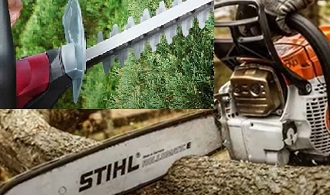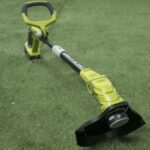As an Amazon Associate, this site earns commissions from qualifying purchases. For more information click here.
Pulling the starter rope to start a chainsaw requires strength, especially the larger models. Is there any way you can get a chainsaw running without using the pull cord? Actually there are several ways to do this, and that is the topic of this article.
There are six ways to start a chainsaw without a pull cord:
- MPI (memory power ignition) technology
- Use a drill
- Auto high idle system
- Spring assist
- CDI (capacity discharge ignition) systems
- Convert the pull starter into electric
Before proceeding, this guide assumes the chainsaw is in working order and you just want an easier way to start it up. It is a good idea to conduct a maintenance check before attempting any of these. If your chainsaw is wet, this guide can help.
Spring Assist Start
Almost all the major chainsaw brands have some sort of spring assisted starter mechanism. There are variations depending on the manufacturer design, but basically it consists of an extra spring situated between the crankshaft and rotor.
You do not need to know how spring assist works to benefit from it. But knowing how it functions will make it easier to understand why the major brands use it.
When you start the chainsaw, its pistons generate force and goes up against the tensioned spring. In these systems, the pre-tensioned spring force is greater than the pistons. It powers the crankshaft and fires up the engine. The Craftsman 41BY4216791 has an easy start mechanism for quick starts.
To put it simply: in some cases the engine compression makes it difficult to start a chainsaw. The force of the assist start system is stronger than the compression so the chainsaw starts more easily.
While there are many types of spring assisted chainsaw systems, they basically do the same thing: unlash the power in the crankshaft to power the engine quickly.
How to Start Chainsaws with a Drill
If your chainsaw simply will not start or you are having a hard time pulling its cord, the old drill method will work.
You will need the following:
- Electric drill
- Socket small enough for the flywheel
- Square head bolt (4 inch, fits in the chuck)
This method works with the Husqvarna 460 Rancher Gas Chainsaw and other major brands.
Instructions
Set the bolt into the socket (use a grinder if necessary) and turn the chainsaw engine on. Get the carburetor primed up and place the socket in the flywheel nut.
With the bolt in the drill chuck, start drilling. It should only take a few seconds before the engine comes to life. This method works well not just with chainsaws but other engines too.
This technique only works with electric drills. Battery powered models do not have enough power to get the engine going.
MPI (Memory Power Ignition) Technology System
MPI is used by Makita in their power tools and similar technologies are employed by other brands. If you are using your chainsaw to cut metal, an easy way to start it up is essential. Technologies like MPI make this possible.
In MPI system the capacitor is set in the ignition coil. As the flywheel runs, the capacitor stores the charge produced by its revolutions. If you have used the chainsaw before, the charges from those revolutions are also kept.
These charges serve as power boosters. When you start the chainsaw, the system draws from these reserve charges.
Because the charge is already there, starting up is faster and easier. The flywheel requires less effort and revolutions to run which is good for the chainsaw in the long term.
A chainsaw that uses MPI technology puts less strain on the machine, reducing wear and tear. The starting process is more dependable and the ignition works better too. This also means less physical effort is needed from you.
CDI (Capacity Discharge Ignition) Systems
A CDI system stores an electric charge. After going through the capacitor, the current is transmitted into the ignition coil. This charge goes into the spark plug which powers up your chainsaw.
With the ignition coil charged up, starting a chainsaw becomes easier. In a typical CDI system the current is relayed into the capacitor, allowing it to generate a charge. The internal mechanism transfers this charge into the spark plug. From there it goes into the engine.
What this means is it takes less physical effort to power up your chainsaw. Another way to think of CDI is that of a transmitter. When the charge or current enters it, the system transmits the power, in this case the ignition coil.
The nice thing about CDI powered chainsaws is one, starting takes less effort. And two, this configuration ensures the chainsaw runs continuously.
Manufacturers use different means to set up their CDI. Most of them include a timing marker, stator, hall sensor, flywheel, charging coil and other parts.
The charging coil generates the electric current for the capacitor. Remember the capacitor transmits this power to the spark plug which goes into the engine.
In a CDI, the system ensures the highest charge is transmitted to the spark plug. The capacitor ignition box receives a pulse from the hall sensor, signaling it to release the charge. The discharge ignition changes depending on how you turn the stator.
Automatic High Idle Technology
Most chainsaws today have an automatic high idle feature built in. What it does it is automatically set the idle to high so the engine receives the right amount of fuel for ignition. Once the mechanism kicks in, the chainsaw will continue to run.
A chainsaw needs a specific amount of fuel to run its engine. Too little fuel and the chainsaw will not run. If there is too much the engine gets flooded with fuel and will not work either. With an automated high idle, the system does it for you.
What makes the auto idle system useful is it takes away the complexity of starting a chainsaw. This is why it is now a common feature in many chainsaws though with varying implementations. If you just purchased a chainsaw from a known brand, chances are it has automatic idle built in.
How to Turn a Chainsaw Pull Start into Electric
If you want to do away with the start pulley and don’t want to buy another chainsaw, you may be able to convert the start cord into an electric starter. Please keep in mind this is only possible with certain types of chainsaws, it will not work with all of them.
The easiest way to turn a chainsaw pull start into electric is to buy a chainsaw electric starter conversion kit. Briggs and Stratton engines for example, can turn electric with a conversion system. These kits are available from the manufacturers.
If you want to manually convert the starter into electric, it may work. Check your owner’s manual first. If it is possible, follow the instructions and buy whatever parts are required.
At the very least you will need flywheel mounting plates and a ring gear. If your chainsaw does not have a ring gear, you must replace it. When the ring gear is ready, place the starter on the mounting boss. Like the ring gear, the mounting boss is a must. Done properly the conversion should work.
How to Start a Cold Chainsaw
You are probably asking, even if the chainsaw has an MPI or CDI feature, can it help start a cold chainsaw? A cold chainsaw means it has never been used before, i.e. newly purchased. Fortunately the process is easy.
Step 1
Make sure you are wearing the right safety gear. Fill the engine with fuel. Follow the manual instructions for mixing.
Step 2
Push the chain forward. You have to do this before you start the engine.
Step 3
Take bar cover off.
Step 4
Activate the decompression valve if available. This is a common feature in modern chainsaws because it makes starting easier. If the chainsaw comes with a starter bulb, turn it on. This also facilitates the startup.

Step 5
Adjust the control lever so it is set to cold/choke start. After pressing the throttle trigger, do the same with the main control lever.
Step 6
Place the chainsaw on a flat surface. Make sure the cutting chain does not touch the ground.
Step 7
Hold the handlebar with your left hand. Hold the starter cord with your right. Position your right toecap in the back handle.
Step 8
Pull the starter cord repeatedly until the engine catches on. Pull up and do not let the cord chafe on the fan casing. The engine will die quickly but that is part of the process. Move to the next step.
Step 9
Set the master control lever up one spot so it is halfway to the throttle. This causes the choke to open.
Step 10
Pull the starter cord again until the engine fires. When it does, hold the throttle trigger monetarily as the master control lever moves back to its original position.
Step 11
Raise the chainsaw but do not touch the trigger.
Step 12
Use your left hand to pull the chain brake in your direction. Do not let go of the handlebar as you do this. When the chain has been freed you will hear a clicking sound.
Congratulations, you just cold started a chainsaw and ready to go.

I love the outdoors and all the tools for maintaining gardens, yards and lawns. The only thing I am more passionate about is sharing what I know about garden and outdoor equipment.


